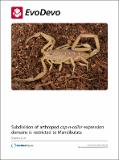| dc.contributor.author | Sharma, Prashant P | en_US |
| dc.contributor.author | Gupta, Tripti | en_US |
| dc.contributor.author | Schwager, Evelyn E | en_US |
| dc.contributor.author | Wheeler, Ward C | en_US |
| dc.contributor.author | Extavour, Cassandra G | en_US |
| dc.date.accessioned | 2014-03-11T13:26:02Z | |
| dc.date.issued | 2014 | en_US |
| dc.identifier.citation | Sharma, Prashant P, Tripti Gupta, Evelyn E Schwager, Ward C Wheeler, and Cassandra G Extavour. 2014. “Subdivision of arthropod cap-n-collar expression domains is restricted to Mandibulata.” EvoDevo 5 (1): 3. doi:10.1186/2041-9139-5-3. http://dx.doi.org/10.1186/2041-9139-5-3. | en |
| dc.identifier.issn | 2041-9139 | en |
| dc.identifier.uri | http://nrs.harvard.edu/urn-3:HUL.InstRepos:11879551 | |
| dc.description.abstract | Background: The monophyly of Mandibulata - the division of arthropods uniting pancrustaceans and myriapods - is consistent with several morphological characters, such as the presence of sensory appendages called antennae and the eponymous biting appendage, the mandible. Functional studies have demonstrated that the patterning of the mandible requires the activity of the Hox gene Deformed and the transcription factor cap-n-collar (cnc) in at least two holometabolous insects: the fruit fly Drosophila melanogaster and the beetle Tribolium castaneum. Expression patterns of cnc from two non-holometabolous insects and a millipede have suggested conservation of the labral and mandibular domains within Mandibulata. However, the activity of cnc is unknown in crustaceans and chelicerates, precluding understanding of a complete scenario for the evolution of patterning of this appendage within arthropods. To redress these lacunae, here we investigate the gene expression of the ortholog of cnc in Parhyale hawaiensis, a malacostracan crustacean, and two chelicerates: the harvestman Phalangium opilio, and the scorpion Centruroides sculpturatus. Results: In the crustacean P. hawaiensis, the segmental expression of Ph-cnc is the same as that reported previously in hexapods and myriapods, with two distinct head domains in the labrum and the mandibular segment. In contrast, Po-cnc and Cs-cnc expression is not enriched in the labrum of either chelicerate, but instead is expressed at comparable levels in all appendages. In further contrast to mandibulate orthologs, the expression domain of Po-cnc posterior to the labrum is not confined within the expression domain of Po-Dfd. Conclusions: Expression data from two chelicerate outgroup taxa suggest that the signature two-domain head expression pattern of cnc evolved at the base of Mandibulata. The observation of the archetypal labral and mandibular segment domains in a crustacean exemplar supports the synapomorphic nature of mandibulate cnc expression. The broader expression of Po-cnc with respect to Po-Dfd in chelicerates further suggests that the regulation of cnc by Dfd was also acquired at the base of Mandibulata. To test this hypothesis, future studies examining panarthropod cnc evolution should investigate expression of the cnc ortholog in arthropod outgroups, such as Onychophora and Tardigrada. | en |
| dc.language.iso | en_US | en |
| dc.publisher | BioMed Central | en |
| dc.relation.isversionof | doi:10.1186/2041-9139-5-3 | en |
| dc.relation.hasversion | http://www.ncbi.nlm.nih.gov/pmc/articles/PMC3897911/pdf/ | en |
| dash.license | LAA | en_US |
| dc.subject | Amphipod | en |
| dc.subject | | en |
| dc.subject | Harvestman | en |
| dc.subject | Labrum | en |
| dc.subject | Mandible | en |
| dc.subject | Scorpion | en |
| dc.title | Subdivision of arthropod cap-n-collar expression domains is restricted to Mandibulata | en |
| dc.type | Journal Article | en_US |
| dc.description.version | Version of Record | en |
| dc.relation.journal | EvoDevo | en |
| dash.depositing.author | Gupta, Tripti | en_US |
| dc.date.available | 2014-03-11T13:26:02Z | |
| dc.identifier.doi | 10.1186/2041-9139-5-3 | * |
| dash.contributor.affiliated | Gupta, Tripti | |
| dash.contributor.affiliated | Extavour, Cassandra | |


